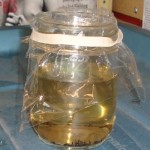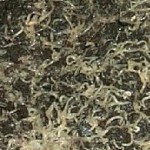Vermicomposting is not an exact science, but it works. What works for you may not however work for others and vise-versa. Given time everyone develops their own unique approach and figures out what works best. Here are some common questions and/or concerns that people have about vermicomposting:
Fruit Flies
One of the most common concerns is the presence of fruit flies. While they are not harmful to your bin, they can create a nuisance in your home. Fruit flies come into your house on the produce you purchase and are not a result of having a worm bin. There are things that you can do to minimize or even eliminate this problem:
- Always bury the fresh food under the bedding and worm castings (compost).
- Store your worm food in a closed container or better yet in your freezer.
- Cover the bedding with a sheet of moist newspaper which will act as additional cover on top of the worm food
- Be sure to keep your counters clean and store fresh food in the fridge whenever possible. For fruits like bananas that do not go in the fridge, consider keeping them under a cake or pie cover to limit their exposure.
 If you do have a problem with fruit flies there are a number of different methods that you can use to get rid of the little pests. The most common is to build a trap using a small amount of apple cider vinegar (you can mix it 1/2 vinegar and 1/2 water) that will both attract and trap the flies. These can be made in a variety of ways to make this trap:
If you do have a problem with fruit flies there are a number of different methods that you can use to get rid of the little pests. The most common is to build a trap using a small amount of apple cider vinegar (you can mix it 1/2 vinegar and 1/2 water) that will both attract and trap the flies. These can be made in a variety of ways to make this trap:

- You can cover the jar with a plastic wrap or a piece of a plastic bag and secure it in place with an elastic. Make a small hole in the top for the flies to enter into the jar.
- Another option that seems to be a bit more effective is to build an inverteed cone from a sheet of paper and place it on top of the jar, securing it in place with some tape to seal it around the edges.
Either way, the flies will enter through the hole and will be unable to find there way out again.
Other Insects
 Other insects and organisms can inhabit your bin including white worms or pot worms (shown in picture), spring tails (small white insects about the size of a flea), and mites (tiny reddish-brown organisms). These should not be a problem unless their populations get out of control, especially mite populations. If this is the case, remove as many mites as possible by wiping the bin or removing bedding materials, add fresh bedding and finely ground egg shells (or other calcium carbonate source) and ensure all food is well buried. Monitor the bin for several weeks.
Other insects and organisms can inhabit your bin including white worms or pot worms (shown in picture), spring tails (small white insects about the size of a flea), and mites (tiny reddish-brown organisms). These should not be a problem unless their populations get out of control, especially mite populations. If this is the case, remove as many mites as possible by wiping the bin or removing bedding materials, add fresh bedding and finely ground egg shells (or other calcium carbonate source) and ensure all food is well buried. Monitor the bin for several weeks.
Odour
There are two main reasons why a vermicomposting bin will smell, there is too much food or it is too wet. Either way there are simple solutions to resolve these problems:
- If when you are feeding your worms you find there is still a significant amount of food in the bin, wait awhile before adding more. Remember that adding food contributes to the moisture in the bin, which is the next problem.
- If the bin is too wet or compacted gently stir the contents and add more bedding material to dry it. This will also allow more oxygen into the bin and reduce the odours. Leave the lid off or ajar to help it dry out more quickly.
Acidity
If it appears that your worms are trying to escape, this may be a sign that the bin conditions are not ideal. One common problem is that the bedding is too acidic. To reduce the acidity add finely ground egg shells (or another calcium carbonate source) and cut down on the amount of acidic food waste such as citrus peels, coffee grounds, tomatoes, etc. Note that it is normal for worms to crawl up the walls of the bin in order to bathe in the warm water that collects on the lid. Unless the worms are escaping through the holes, this behaviour probably does not indicate that your bin conditions are problematic.
Questions?
- Give us a call: toll free at 1-866-394-8880 or in Winnipeg at 925-3777
- Drop us an email at compost@greenactioncentre.ca




Recent Comments